Roofs can get very dirty over time, and a pressure wash can help remove all the built-up dirt, dust, and debris.
It’s possible to restore the roof’s color and integrity with a pressure wash.
A pressure wash can help increase the roof’s life by removing any moss or algae that may be growing on it.
A roof pressure wash is a cost-effective way to preserve and maintain your roof in excellent working order.
A pressure washer is a versatile tool in any homeowner’s arsenal. Still, if you’re looking up at a dirty roof and wondering if you can blast the grime away with your handy power washer, be warned — that probably isn’t such a good idea.
Read on to find out How Pressure Wash A Roof can be dangerous and how you should do it instead!
What Are The Benefits Of Pressure Washing My Roof?
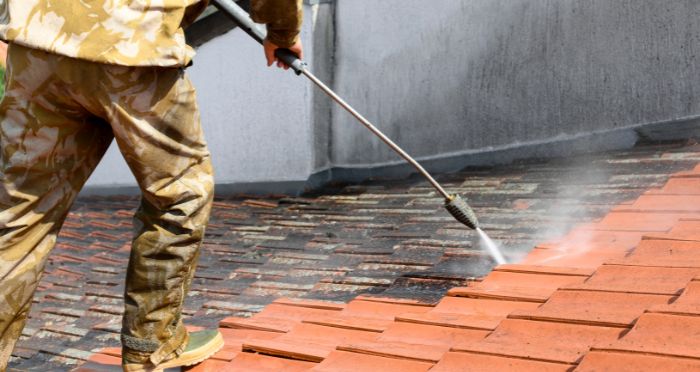
Improving the Life of Your Roof
The best reason to pressure wash a roof is to extend how long you have your roof before needing a replacement. When dirt and debris build up on the surface of shingles, they don’t work as well at protecting the home underneath them from extreme weather conditions like sun exposure or heavy rainfalls.
Increasing Your Property Value
Pressure washing a roof is also beneficial because it can increase how much you could get if the home sells. In addition, a clean house or apartment will be more attractive and eye-catching than one with dirt muddying its exterior.
So owners who pressure wash their roofs stand to see how much for which they can sell their houses, how much quicker they’ll sell, and how long it will be before the roof needs to be replaced.
Reducing Energy Costs
The third benefit of pressure washing a roof is saving how much you pay for energy costs. Cleaner roofs will reflect more heat than dirty ones. It means there’s less chance the sun will heat the home underneath them and cause air conditioning bills to rise along with temperatures inside.
Pressure Washing Will Save You Money
There’s how much money to save by pressure washing a roof, which can be substantial. The cleaner the house is when it goes on sale, the faster you will get your asking price or how much you can sell your home.
Before You Pressure Wash Your Roof, Consider These Things
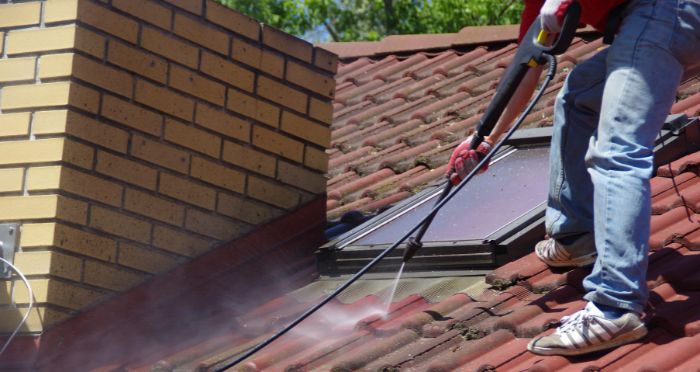
Start On The Far End From The Ladder
Make sure you start at the far end of the roof from your ladder and spray yourself out, so you don’t get trapped in a corner. That way, if you accidentally spray yourself or slip off the edge (which can happen!), you’ll land on something other than the concrete below.
Inspect The Roof
Look for any problem spots, areas of peeling paint, or rotten patches of wood. If you find any defects that need work, do those before cleaning the rest to avoid damaging your roof further and causing more problems.
Avoid Direct Sunlight
If possible, try not to wash the roof when it is in direct sunlight because it will dry up all the water, leaving behind a dusty residue.
Begin With Detergent
When cleaning your roof, start with some water and detergent before getting the pressure washer involved. It will make it easier to clean off any stubborn dirt or grime while preventing damage to the shingles of your roof.
Set a low PSI for the cleaning
Experts recommend pressure washers between 1200 and 1500 PSI to clean clay roof tiles. Depending on how filthy your roof is, you may need cleaning chemicals. In many situations, the water pressure is enough to clean the roof.
Be Gentle With The Pressure Washer Nozzle
You’ll want to use only the gentlest setting on your pressure washer. The lower the PSI (pounds per square inch), the less likely you will damage or warp your shingles.
The white nozzle delivers a strong spray with a 40-degree pattern. It’s the most widely used spray pattern, perfect for quickly cleaning surfaces. This nozzle is also great for rinsing dirty dishes after using some chemical cleanser. It’s also fantastic for starting your roof cleaning project.
Don’t Get Too Close
Your goal is not to pry shingle pieces up with your powerful spray but to get rid of all that built-up grime. Keep your nozzle a reasonable distance away from the roof and use only enough pressure to remove that dirt, not much more.
Use A Lower Setting
Your shingles are a little more delicate than they look. Some pressure washers can punch a hole right through the shingles at the highest settings, leaving them vulnerable to leaks and other problems. Make sure you use a lower setting so that your roof stays resilient against any damage.
Don’t Spray Up, Spray Down
When you’re done, stand on the ground and spray down your roof with a gentle rain-style shower. If possible, use something to catch any runoff that may damage plants or patio furniture below.
To adjust the sprayer, move it, not the power setting
When you’re done with your roof, move the sprayer from one side to the next in gentle sweeps rather than dragging it behind you. If you need more pressure near an obstacle like a vent or skylight, hold off until transparent, and then use that section as your starting point for another sweep across the length of your roof.
Be extra careful when you’re on the ladder
Pressure washing your roof is a pretty intense activity, so you must be extra careful while doing this kind of work. Make sure you have someone watching how steady your ladder is before climbing up. Also, stay clear of any power lines or other electrical hazards.
How To Pressure Wash A Roof: Easy Steps
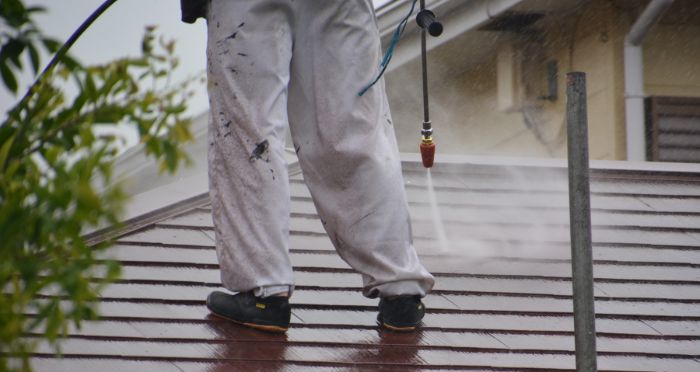
Pressure washing your roof is a great way to keep it clean and free of debris. But, if you’re not careful, you can cause serious damage to your roof. That’s why it’s important to use a low-pressure wash technique, which roofers call a “soft wash.”
To pressure wash your roof without damaging it, you’ll need a pressure washer with a special nozzle tip. This will allow you to clean even the most brittle roofing materials, like asphalt, without causing any damage.
Here are easy steps for pressure washing your roof:
Step 1: Wet the roof with a garden hose in a low-pressure setting.
Step 2: Apply bleach or chlorine-based gel to the roof.
Step 3: Allow the gel to sit for the recommended cleaning time.
Step 4: Rinse the roof from the top down with the pressure washer.
Tips: Check the weather forecast and ensure it will not rain in the next few days.
Recommended Pressure Washers to Clean a Roof
[amazon box=”B07VRFNXDG”]
[amazon box=”B083B5KLQ6″]
Recommended Chemicals to Clean a Roof
[amazon box=”B07Q811KR4″]
[amazon box=”B0019KSUG6″]
Safety Tips for Pressure Washing A Roof
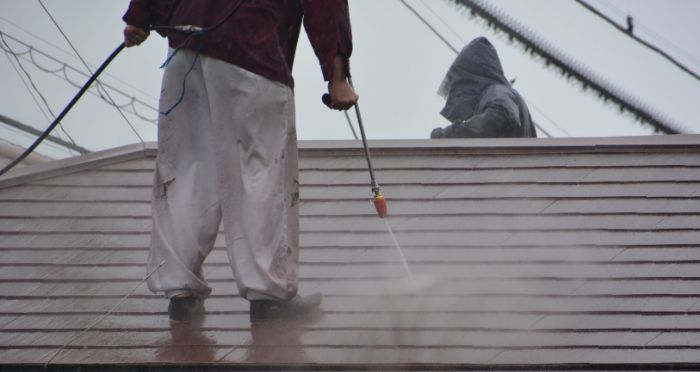
Here are some safety tips to follow when pressure washing your roof:
- Wear the appropriate safety equipment, such as goggles and ear muffs.
- Put on rubber boots and gloves to protect yourself from chemicals during cleaning.
- Use detergent with water when washing a roof or deck surface to avoid damaging the wood, siding, stucco, etc.
- Use a suitable spray nozzle when pressure washes the roof.
- Determine how high you want to work on the ladder when cleaning your house’s exterior and how much of it you can reach comfortably from that height without straining or stretching.
- Keep away from hot surfaces you’re working on with your power washer. It can cause severe burns like those caused by scalding hot water coming out of a kitchen faucet or showerhead.
- Never point the pressure washer nozzle up at the sky or anyone while the machine is running. The high-pressure stream of water can cause serious injury.
- Avoid using a pressure washer on a very steep roof. It’s easy to lose your footing, and the machine can slip out of your hands.
- Don’t stand on or lean against gutters, downspouts, or skylights while pressure washing your roof. These areas are not designed to support your weight, and you could fall and injure yourself.
- If you’re going to be pressure washing for an extended period, take breaks often to avoid fatigue. Also, it’s easy to dehydrate when working in hot weather, so drink plenty of water.
- Never leave the pressure washer running unattended. Please turn it off and unplug it when you’re not using it and before making any adjustments.
Why Pressure Washing Certain Dirty Roof Types Not A Good Idea?
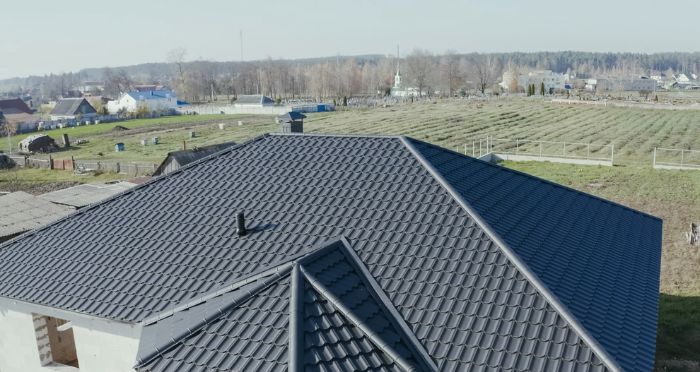
It’s no secret that roofs can get pretty dirty. All that grime, dust, and debris can take its toll after a while, making your roof look dull and discolored. But while it might be tempting to grab a pressure washer and blast away all that dirt, that’s not the best idea.
Why? Because pressure washing certain types of dirty roofs can do more harm than good. Here’s a look at a few of the potential problems that can occur when you pressure wash your roof:
- Dispersing fungus, moss, and other organisms to other roof parts.
- Clay, shake, slate, cement, and metal roofs are susceptible to fractures or cracks.
- Removing the granules from asphalt shingles.
- Puncturing or damaging the roof membrane.
Wrap Up – How To Pressure Wash A Roof
You can’t pressure wash your roof with a power washer. Instead, you should use this information to clean up the mess on top of your house safely and effectively!
If you want more tips like these, then let us know – we’re always happy to help homeowners get their houses looking spick-and-span again!
FAQs
Can You Pressure Wash Asphalt Shingle Roofs?
It is possible to pressure wash an asphalt shingle roof, but it is not recommended. The high pressure can damage the shingles and shorten their lifespan. A better option is to use a soft wash with low pressure to clean the roof without damaging it.
What are the basic steps of pressure washing a roof?
Basic roofs can be cleaned with a garden hose and sprayed broadly across the entire roof.
- Start from the bottom and work your way up.
- Use a weakened bleach solution to remove stains caused by moss or mildew.
- You can also use trisodium phosphate (TSP) to remove these types of stains.
- When in doubt, always contact the manufacturer of your roofing material to see what they recommend before attempting any cleaning on your own.
When Should You Hire Experienced Roof Cleaners?
The best time to hire experienced roof cleaners is when you have little or no experience with power washing. That’s because experienced professionals know how to clean roofs safely and effectively and can help you avoid damaging your property.
Suppose you’re unsure whether it’s the right time to hire professional roof cleaners, contact a local company for a consultation. They’ll be able to assess your situation and recommend the best course of action.
When is DIY Roof Power Washing a Good Option?
If your roof is made of asphalt, tile, slate, metal, or wood, then a DIY power washing might be a good option.
When should you avoid DIY power Washing?
As the old saying goes, “if it ain’t broke, don’t fix it.” The same can be said for power washing your roof. Power washing it yourself is probably not a good idea unless your roof is made of one of the more durable materials, like concrete or steel.
Not only could you damage your roof, but you could also seriously injure yourself if you’re not careful. So please leave it to the professionals.
Shop Related Products
[amazon bestseller=”pressure washer”]